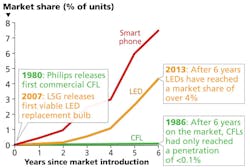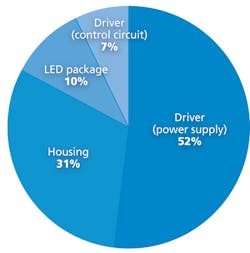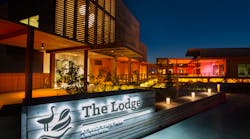SSL uptake is happening much faster than that of CFL products, reports JAMES BRODRICK of the US DOE, but a new report uses lessons learned to outline steps the industry should take to move forward more rapidly.
Solid-state lighting (SSL) has made impressive progress over the past decade, emerging as a promising new technology that could fundamentally alter and improve lighting systems, and significantly lower energy use and costs. Benefiting from lessons learned from the market introduction of compact fluorescent lamps (CFLs) in the 1980s and 1990s, actions taken by the US Department of Energy (DOE) in Gateway, Caliper, Lighting Facts and other programs (Fig. 1); energy efficiency programs; and standards organizations have helped industry avoid some of the problems that plagued CFL market development. Still, the lighting industry faces challenges in the SSL transition and can continue to benefit from lessons learned in the early stages of SSL deployment.
Efforts by the DOE and other organizations have positively impacted the experience of LED-lighting adopters. Indeed, the adoption of LED lighting is happening far faster than did the adoption of CFLs, although not nearly as fast as some consumer electronics technologies (Fig. 2). The success is in part due to standardized testing, minimum performance and reporting requirements, and publication of testing and demonstration results that have made it more difficult for poor-performing SSL products to remain on the market, and rewarded manufacturers whose products perform well.
Looking ahead, however, the full performance and energy savings potential of SSL is far from realized or assured. With that in mind, the DOE’s new report, "Solid-state lighting: Early lessons learned on the way to market," analyzes actions taken thus far and identifies challenges, new lessons, and their implications for the future. The result is a compilation of analysis and recommendations for consideration by manufacturers, standards organizations, energy-efficiency programs, retailers, specifiers, and other stakeholders — intended to stimulate further discussion and to aid in the continuous course corrections needed to achieve SSL technology’s full potential. The report is available online at www.ssl.energy.gov/tech_reports.html, and we will examine some of the key lessons here.
Lesson 1: Rigorous testing requirements adopted in the early days of SSL development were necessary to counter exaggerated claims of performance by some manufacturers, but they eventually led to unreasonably high testing costs.
The exploding number of products and product variations coming to market has created a testing burden that can boost product prices and slow product introductions, which in turn can slow market adoption and associated energy savings. Family grouping policies have been the primary means used by energy-efficiency programs for addressing the testing burden issue.
The voluntary qualification and listing groups — such as the DesignLights Consortium (DLC), Energy Star, and DOE LED Lighting Facts — should consider increased coordination to continue to reduce the testing burden on manufacturers, while maintaining the integrity of product data through random verification testing. In addition, the lighting community should consider continuing to seek methods and strategies to reduce the overall testing burden on manufacturers, as confidence in LED performance continues to increase.
Lesson 2: Despite the promise of long life, there’s no standard way to rate the lifetime and reliability of LED lighting products.
Variability in lifetime and reliability of similar products needs to be reduced to improve market adoption of LED products. There are many sources of failure in SSL products that must be accounted for (Fig. 3). Uncertainty is slowly being reduced, as efforts are made to standardize methods for predicting lifetime and reliability. Standards developers are working on new tools and metrics, some of which will still be limited in their usefulness, but these tools and metrics are needed to address this challenge.
Some manufacturers are providing longer warranties for products serving key applications and market sectors, which represents another way to overcome uncertainty. Innovative product designs and increased use of lighting controls may further complicate the measurement and reporting of LED product lifetime and reliability in the near future, and all market actors need to work together to explore the effect of such features on lifetime and reliability, as well as educate users.
Lesson 3: Although specifiers prefer complete families of products, the rapid evolution of LED technology presents a challenge to manufacturers in creating and maintaining complete product lines.
Specifying families of luminaires allows for a consistent look and feel throughout a space and can also standardize maintenance and spare parts. But manufacturers sometimes lack the time to develop full product ranges, or find it difficult to keep products consistent with one another when LED packages and drivers are changing so rapidly. Without the option of product families, some specifiers may have trouble using LED products across their projects.
Manufacturers should consider providing a range of lamps or luminaires with similar appearance, but with different photometric performance. When an LED lighting product is superseded by one with greater lumen output, manufacturers should consider keeping both in the product line. Developing one or more forms of relative testing standards may help manufacturers manage the cost of testing product families.
Lesson 4: The range of color quality available with LED lighting products, and the limitations of existing color metrics, may confuse users.
While the availability of LED products with a range of color qualities may be an asset in one sense, the variability also presents a number of challenges. Addressing these challenges will require a range of coordinated industry efforts. Retailers should continue their efforts to provide clear information regarding color quality, especially the difference between CCTs. Efforts to improve the consistency of information on product packaging should also continue, and industry should establish effective color communication tools to simplify product selection.
At the same time, the lighting research community should consider establishing performance criteria for color rendering that will ensure acceptability to a majority of users. Standards organizations should consider establishing tighter tolerances for chromaticity bins, to reduce product-to-product variability at the same CCT, making it easier to specify various LED products in the same space. Revised, new, or additional color rendering metrics are needed to accurately characterize the color rendering capability of all light sources.
Lesson 5: The color delivered by some LEDs shifts enough over time to negatively impact adoption in some applications.
The ability of LED lighting products to maintain chromaticity over long lives has been demonstrated by the DOE L Prize winner, but not all products perform at that level, and performance can vary significantly (Fig. 4). Color stability measurement and prediction methods are needed to enable performance comparisons between LED lighting products. There’s a need for energy-efficiency programs and product information qualification standards that include color stability metrics.
Efforts to establish new methods and metrics for color stability assessment should continue. With standards and metrics, color shift can rightfully be included in a yet-to-be-developed comprehensive lifetime rating for LED lighting products. Manufacturers and related industry committees should continue to share test methods and data for use by standards organizations, and these organizations should consider incorporating the new knowledge generated into standards for color stability.
Lesson 6: Some LEDs flicker noticeably, which may negatively impact adoption in some applications.
Whereas conventional lighting technologies exhibit flicker in a fairly similar manner that in many cases can be remediated with appropriately designed ballasts, there is significant variation in flicker for LED sources. Standards organizations should consider developing a measurement procedure for flicker and a flicker metric that accounts for frequency, so manufacturers can communicate product performance (Fig. 5).
Manufacturers should consider evaluating and communicating the flicker performance of their products both at full output and when dimmed, accounting for dependencies on the selection of control equipment if applicable. The lighting research community should consider conducting research to establish thresholds for detection of (and perhaps objection to) flicker, risk of neurological impacts, and degradation in task performance for different applications.
Lesson 7: LEDs can cause glare, which may negatively impact adoption in some applications.
Some of the glare issues with SSL have been caused or exacerbated by the drive to increase lighting output (e.g., by using higher-output LEDs) and reduce cost (e.g., by using fewer LEDs), so one challenge in addressing glare will be finding the balance between potentially competing goals. The industry should continue working on developing LED lighting solutions that don’t increase glare relative to incumbent technologies. DOE and research organizations should consider routinely including glare assessments in product and application evaluations and demonstrations.
Where a standard glare assessment methodology isn’t available, these organizations could work toward establishing new methods and metrics for glare assessment. Manufacturers should continue to optimize their use of optical solutions that reduce source luminance, especially for applications where the incumbent light source is much lower in luminance than a typical LED source. Energy-efficiency programs should consider the implications of glare control when establishing efficacy standards for products.
Lesson 8: Achieving high-quality dimming performance with LED lamps is difficult, but the situation is improving.
While there’s no standard definition of "dimmable," the ability of all incandescent sources to dim smoothly down to light levels below 1% serves as the unofficial benchmark, and the comparatively poor dimming performance of many LED lamps is limiting their adoption. Retailers, manufacturers, and organizations promoting the purchase of dimmable LED integral lamps should consider increasing their education efforts in this area, alerting buyers to potential dimming problems and working together to develop better, clearer, and more consistent means for communicating dimming guidance to buyers.
Industry should consider developing LED lamps capable of high-performance, incandescent-like dimming with high efficacy over the dimming range, and should improve predictability of dimming performance for specifiers and buyers. In addition, industry should continue the development of advanced dimming circuitry compatible with phase control, as well as forward-looking standards for phase-cut dimmers and lamps, and should continue developing and promoting alternative approaches that have the potential to avoid many of the compatibility issues inherent to phase control.
Lesson 9: Greater interoperability of lighting control components and more sensible specifications of lighting control systems are required to maximize the energy savings from LED lighting.
The controllability of LEDs significantly increases the potential for energy savings. LED technology is poised to bring high-performance, low-cost control of output level and color to many lighting applications for the first time. Integrating lighting controls with a communication network offers additional opportunities to provide value and perhaps save money and additional energy. The ability to track energy use and report failures can reduce maintenance costs and save even more energy in some instances.
As the market matures, maximizing the energy savings from LED lighting systems will become increasingly dependent on maximizing the successful installation of lighting controls that suit the use and the user. Industry should continue to develop and refine educational and certification programs aimed not only at selecting and designing for control strategies but at ensuring that the specified lighting control equipment suits both the use and the user and is correctly installed and fully commissioned.
Manufacturer consortia should continue their efforts to develop open-standard specifications and compliance testing programs that allow lighting control products to be brought to market that offer new features and deliver some level of interoperability. Energy-efficiency organizations should consider focusing their lighting control incentive programs on interoperable equipment.
Lesson 10: Lack of LED lighting product serviceability and interchangeability has created market adoption barriers in certain sectors.
Early experiences with some LED lighting products has shown that, while the LED packages themselves may be long-lived, driver failure or shifting color can cause what initially looked like a successful installation to fall short of client expectations. Modular luminaire designs may allow for only the failed component to be replaced, reducing the risk of unmet lifetime expectations and also entailing lower life-cycle costs.
Knowing that tomorrow’s products will perform better than today’s can make it hard for lighting designers to decide when to start specifying LED products. Luminaires designed with interchangeable components, such as LED modules or light engines, allow users to take advantage of evolving LED technology by, for example, easily upgrading to deliver higher efficacy or the ability to control color temperature when such features become available. Industry should consider adopting standardized modular interfaces and developing products with serviceable or interchangeable components.
Lesson 11: Existing lighting infrastructure limits the full potential of SSL; more effort is needed to open the doors to new lighting systems and form factors.
Almost the entire SSL market remains focused on products that fit into the existing infrastructure of legacy lighting products. While this is a necessary and expected consequence of introducing a radically new technology into a mature market, this current focus sharply limits the potential of the new technology.
Government organizations, codes and standards bodies, and specifiers need to be mindful that their lighting requirements may restrict product form factors, functionality, and system operation. Careful development of these requirements opens the door to innovation and better product designs. Energy-efficiency programs should consider explicitly allowing for nonconventional form factors and functionality and, where possible, should move away from program designs built around the concept of one-for-one product substitutions.
Buyers are more likely to buy products not compromised by the legacy infrastructure if those products offer compelling functionality. Manufacturers, lighting educators, the DOE, and others could induce earlier customer acceptance of lighting products by frequently raising the issue of what SSL is capable of when unconstrained by existing infrastructure. Manufacturers with innovative product designs at the ready will be in the best position to leverage this new opportunity.
Lesson 12: Programs that provide ways to identify quality LED products have helped support market adoption.
Verified test data and independent product qualification are essential to help utilities, energy-efficiency programs, retailers, and consumers evaluate LED lighting products. But keeping pace with LED lighting technology is a challenge for qualification programs that have minimum performance requirements. Efficiency programs should consider prioritizing the development of custom options that help users identify quality LED lighting products. These programs should target energy-efficiency performance that will produce significant energy savings if the technology is widely adopted in the market.
Efficiency program requirements need to keep pace with LED technology development, balancing energy efficiency, lighting quality, and cost considerations. Testing and documentation requirements should be streamlined as much as possible, while still maintaining confidence in qualified product performance claims. Wherever possible, data should be shared across the various performance verification programs, to save time and expense for all participants.
JAMES BRODRICK is the lighting program manager at the US Department of Energy.










